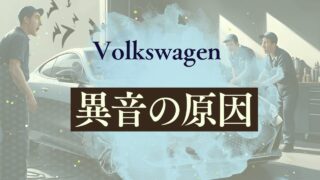Modern Volkswagens and Audis have largely moved from lever-type parking brakes to Electric Parking Brakes (EPB) operated by a switch.
EPB is convenient and integrates with driver-assist features, but in cases like flooding, a dead battery, or control faults, the brake may stay engaged and the vehicle cannot be moved—even onto a flatbed.
This guide explains how EPB works, why the car becomes immobile, and a safe, manual release using a VW Golf 7 as the example.
We’ll also cover the post-repair “basic settings” (initialization) required to restore normal operation and avoid warnings or brake drag.
Video reference (JP): NILE Mecha Channel — “How to Manually Release the Electric Parking Brake (VW/Audi)”
- How the Electric Parking Brake Works
- Why the Car Becomes “Impossible to Move”
- Emergency Workaround (Manual Release Concept)
- Prep Before You Start
- Removing the EPB Motor
- Manual Release: Step-by-Step
- After Release: Safety Notes
- Post-Repair “Basic Setting” (Initialization)
- Know the Structure, Handle the Trouble
- FAQ
How the Electric Parking Brake Works
What EPB Is
The Electric Parking Brake (EPB) is an electronically controlled parking brake widely used on modern Volkswagen and Audi models. Instead of a lever or pedal, you pull a switch.
A small electric motor inside each rear caliper then pushes the piston, clamping the pads and holding the car.
How It Differs from Cable-Type Systems
Traditional handbrakes use your arm strength via a lever and cable to pull the pads against the disc.
EPB drives the caliper piston directly with a motor—no cable—improving packaging space, control precision, and integration with driver-assist features like Auto Hold.
Linked to Control Units
EPB isn’t just a switch; the caliper motors and the brake/EPB control unit constantly communicate.
They consider vehicle speed, gear position, pedal inputs, and more to prevent accidental hard braking.
Many models also auto-apply the EPB when you shift to Park, as long as the car has power.
Benefits and a Key Caution
Button-simple, repeatable clamping force without relying on driver strength.
But because it depends on power and signaling, a dead battery or electrical fault can leave the brakes stuck on—the most common “can’t move the car” scenario.
Why the Car Becomes “Impossible to Move”
No Power, No Release
EPB clamps and releases via electric motors.
If battery voltage collapses, there’s no way to send a release command. The brakes stay clamped; pushing the car won’t rotate the wheels.
Common Root Causes
Modern cars are power-hungry; when voltage drops, not just EPB but shift control, EPS, etc., can also stop.
Park-Pin Makes It Worse
In P (Park), the transmission’s parking pawl locks the driveline. If EPB is clamped and the transmission is in P, both the brakes and the driveline can be locked. Without electrical power, even pressing the shift-lock button often won’t get you to N.
Why Towing Is Hard
With wheels locked, winching can damage the transmission or driveline.
The safe way out is to mechanically back the pistons off the rear calipers so the wheels can turn.
Emergency Workaround (Manual Release Concept)
You can release the brakes even with no power by removing the rear caliper’s EPB motor and manually rotating the internal drive to retract the piston.
This is a last-resort, move-the-car-only procedure—useful after flooding, long storage, or total battery failure—so you can push/roll the car to a safe spot or onto a flatbed.
It is not a repair and not for driving.
Prep Before You Start
Safety First
Work on a flat, stable surface. Chock the wheels front and rear.
Even with the brakes on, don’t trust friction alone.
Gear Position and Power Check
If there’s still a little power, selecting P before starting can help prevent unintended movement during the procedure.
If the battery is completely flat and you must reposition the car later, you may need to use the mechanical shift-lock to get N—but prioritize stability and chocks.
Tools You’ll Need
Target Location
The EPB motor sits on the rear caliper (one per side), a rounded plastic unit with an electrical connector. Removing it exposes the drive spindle that moves the piston.
Removing the EPB Motor
- Identify the motor on the back of each rear caliper. Check both sides; packaging differs by model.
- Disconnect the electrical connector by depressing the tab; don’t pry aggressively or you’ll crack the latch.
- Remove the two T30 Torx bolts securing the motor to the caliper. An extension helps in tight wheel-well spaces.
- Pull the motor straight back. You’ll see the metal spindle/drive in the caliper body.
Removing the motor does not release the brake yet. The piston is still clamped.
Manual Release: Step-by-Step
Spindle Shapes Vary
With the motor off, look at the central spindle. On many VW Golf 7 rear calipers it appears star-shaped; some Audi models show a multi-spline (12-point) style. Use a tool that fits securely—rounded or slipping tools can damage the spindle.
Retract the Piston
Rotate the spindle clockwise (right-hand) to retract the piston. (Counter-clockwise re-applies clamp.)
Go slowly and steadily—internal gears can be polymer; brute force can strip teeth.
How to Confirm
After roughly 10–15 turns, the piston should be retracted enough that the wheel spins freely by hand. Do both sides so the car rolls smoothly. If one side won’t retract, suspect seized internals; stop and consult a specialist.
Small Tips
- Firm, controlled grip with pliers; don’t crush the spindle.
- A bit/ratchet that fits the profile can help, but over-torque risks damage.
- Spin the wheel to feel for drag; any resistance suggests more retraction is needed or a separate issue.
Once retracted, the parking function is disabled. Chock wheels before moving on.
After Release: Safety Notes
Post-Repair “Basic Setting” (Initialization)
Motor Refit Isn’t Enough
After removing/refitting or replacing an EPB motor, the control unit no longer trusts its stored piston position. You must run a basic setting (a.k.a. service mode or initialization) so the ECU relearns the end-stops and working range.
Purpose
The basic setting fully extends and then retracts the piston under control, allowing the ECU to record the correct reference position. Skipping this can cause over-clamp, under-clamp, pad drag, or warning messages.
Typical Procedure (VCDS/ODIS etc.)
- Ignition ON (engine OFF).
- In the scan tool, select EPB/Brake.
- Choose Basic Settings / Service Mode.
- Follow prompts (open → close cycle).
- Confirm completion; clear any DTCs and verify no warnings remain.
If a Scan Tool Isn’t Available
Some older systems can relearn if you refit the motor, then cycle the brake pedal and EPB several times. Treat this as temporary; verify later with a proper scan-tool basic setting.
Warning Lamps
If the EPB/Brake warning persists after refit, perform basic setting and clear codes. If it remains on, diagnose wiring, motor current draw, and mechanical binding.
Know the Structure, Handle the Trouble
FAQ
Q1. EPB won’t release—what’s the first check?
Check battery voltage. Low voltage prevents the motors from receiving a valid command. A jump starter may let you release normally. If not, suspect the motor or control side.
Q2. Can I drive after manual release?
No. Manual release retracts the piston; the parking function is inactive. Use chocks/P and move only short distances by pushing/winching.
Q3. What if manual release won’t turn?
Forcing it can strip gears or jam the piston. Apply a small amount of penetrating oil and try again gently, or stop and have a specialist inspect it. Use a properly fitting tool for the spindle profile.
Q4. Refit the motor but the warning stays on.
That usually means basic setting not completed. Run the EPB service procedure with a scan tool and clear DTCs.
Q5. Flooded car—still possible to release by hand?
Yes. You can mechanically retract the piston even if the motor’s flooded. But don’t power up wet harnesses; dry/clean and then diagnose at a shop.
Q6. Does frequent EPB use shorten its life?
Not typically. Inactivity is more likely to cause sticking. Regular use helps keep the mechanism free.
Q7. EPB glitches after a battery change?
It can happen. Power loss can temporarily confuse learned positions. Cycle the EPB several times; if warnings persist, perform basic setting with a scan tool.
Safety disclaimer: This guide is for emergency movement only. If you are unsure about any step, consult a professional technician. Improper work on brake systems can cause serious injury or damage.






-2-120x68.jpg)
コメント